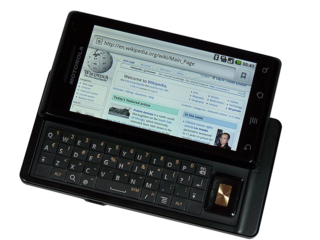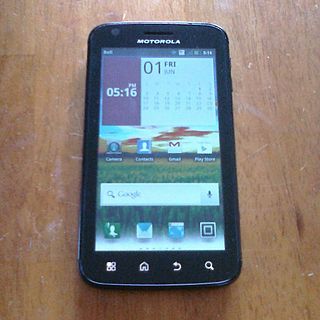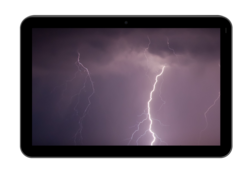Motorola Mobility LLC, marketed as Motorola, is an American consumer electronics manufacturer primarily producing smartphones and other mobile devices running Android. It is a subsidiary of the Chinese multinational technology company Lenovo.
This is a list of tablet computers, grouped by intended audience and form factor.

The Motorola Droid is an Internet and multimedia-enabled smartphone designed by Motorola, which runs Google's Android operating system. The Droid had been publicized under the codenames Sholes and Tao and the model number A855. In Latin America and Europe, the model number is A853 (Milestone), and in Mexico, the model number is A854 (Motoroi). Due to the ambiguity with newer phones with similar names, it is also commonly known as the DROID 1. The brand name Droid is a trademark of Lucasfilm licensed to Verizon Wireless.

The Droid X is a smartphone released by Motorola on July 15, 2010. The smartphone was renamed Motoroi X for its release in Mexico on November 9, 2010. The Droid X runs on the Android operating system, and the latest version supported was 2.3 Gingerbread. It was distributed by Verizon Wireless in the United States and Iusacell in Mexico.

The Samsung Galaxy Tab 7.0 or simply Samsung Galaxy Tab is an Android-based mini-tablet computer produced by Samsung. Available from 5 November 2010. The tablet was first introduced on 2 September 2010 at the IFA in Berlin. The Galaxy Tab was the first Samsung Android-powered tablet to be released.

The Nexus S 4G is a smartphone co-developed by Google and Samsung and manufactured by Samsung Electronics for release in 2010. It was the first smartphone to use the Android 2.3 "Gingerbread" operating system, and the first Android device to support Near Field Communication (NFC) in both hardware and software.

The Motorola Atrix 4G is an Android-based smartphone by Motorola, introduced in CES 2011 on January 5, 2011. It was made available in the first quarter of 2011. It was introduced along with three other products, Motorola Xoom, Motorola Droid Bionic, and Motorola Cliq 2. It uses an NVIDIA Tegra 2 dual core processor. It is the first phone to use a quarter-HD PenTile display with 24-bit graphics. The Motorola Atrix 4G is carried by the following wireless providers: AT&T Wireless US, Orange UK, Bell Canada CAN, Telstra AU. AT&T released Atrix on March 6.

The Motorola Droid Bionic is an Android-based, 4G LTE-capable smartphone designed by Motorola. It was originally scheduled for release in Q2 2011 but was delayed, eventually being released on 8 September 2011.

Android Honeycomb is the codename for the third version of Android, designed for devices with larger screen sizes, particularly tablets, however has been unofficially ported to the Nexus One. It is the third major release of Android and is no longer supported. Honeycomb debuted with the Motorola Xoom in February 2011. Besides the addition of new features, Honeycomb introduced a new so-called "holographic" user interface theme and an interaction model that built on the main features of Android, such as multitasking, notifications and widgets.

Xperia Tablet, formerly known as Sony Tablet, is the brand name of a series of tablet computers. The first models originally ran Google's operating system Android 3.1 Honeycomb, but more recent models operate on the Android 4.1.2 system. The first models were informally announced on 26 April 2011, using the code names, by the Sony Corporation in the Sony IT Mobile Meeting. They featured touchscreens, two cameras, infrared sensor, Wi-Fi. Also, they support PlayStation Suite, DLNA, and are 3G/4G compatible. The retail price in the U.S at the time of release was US$499–599. In Europe, prices were at €499. To increase the number of apps available and provide marketing support for both tablets, Sony and Adobe Systems will hold a $200,000 competition targeting app developers. The series was formally launched in Berlin and Tokyo on 31 August 2011. The latest in the series is the Xperia Z4 Tablet.

The LG Optimus Pad is a tablet computer developed by LG Electronics for its own line-up and for specific mobile carriers in selected countries. Mobile carries include NTT DoCoMo and T-Mobile which unlike its domestic rival, Samsung offering the same tablet model for specific carriers, LG does not alter the specs of those they release to these carriers and the only alteration is on the addition of the mobile carriers logo on it. The LG Optimus Pad was first released in South Korea in April 2011 and then in the US in March 2011 which is also known as the T-Mobile G-Slate. It is LG's first device running Android 3.0 ("Honeycomb") and appeared at the Mobile World Congress in February 2011.

The Motorola Milestone XT720 is an Android-based smartphone manufactured by Motorola Mobility, originally released in July 2010. Announced in June of that year, it was the first Motorola Android phone with xenon flash.

The Motorola DROID 3 is a smartphone released on July 7, 2011, by Verizon Wireless running the Android 2.3 operating system by Google. It comes with 16 GB of internal storage. The smartphone does not ship with a microSD card. It has a 4-inch qHD display and an 8-megapixel camera capable of recording 1080p video. Unlike the DROID 2, the Motorola DROID 3 features a 5-row QWERTY keyboard, with a dedicated number row. It also has a VGA front-facing camera for video calls. The Droid 3 ships with Android 2.3.4 (Gingerbread) with Motorola's updated proprietary Motoblur UI. Like other contemporary Motorola phones, it has a locked bootloader.

The Verizon Droid Razr is an Android-based, 4G LTE-capable smartphone designed by Motorola that launched on Verizon Wireless on November 11, 2011. It was announced on October 18, 2011 in New York City.
The Motorola Droid Xyboard, previously released as the Xoom 2 in Europe before being renamed, is an Android-based tablet computer by Motorola Mobility, announced by Motorola on November 3, 2011.

The Motorola Droid 4 (XT894) is a smartphone made by Motorola Mobility. It was released with Android 2.3 and can be upgraded to Android 4.1. It was released on Verizon Wireless's network on February 10, 2012. It is the successor to Motorola's Droid 3, and is one of the first smartphones to support GLONASS in addition to GPS.

Android Jelly Bean, or Android 4.1 is the codename given to the tenth version of the Android mobile operating system developed by Google, spanning three major point releases. Among the devices that run Android 4.1 to 4.3 are the Nexus 7 (2012), Nexus 4, Nexus 10 and Nexus 7 (2013).

The Nexus 6 is a phablet co-developed by Google and Motorola Mobility that runs the Android operating system. The successor to the Nexus 5, it is the sixth smartphone in the Google Nexus series, a family of Android consumer devices marketed by Google and built by an original equipment manufacturer partner. Nexus 6 and the HTC Nexus 9 served as the launch devices for Android 5.0 "Lollipop".

Moto G4 is a line of Android smartphones manufactured by Motorola Mobility, a subsidiary of Lenovo. They are the successor to the third-generation Moto G, and were first released in Brazil and India on May 17, 2016, with the other markets following.

Iqbal Arshad is an American engineer, inventor, speaker and technology executive. He has served as the senior vice president of engineering and global product development at Motorola Mobility, Google and Lenovo, and has been responsible for design and development of industry-leading smartphones, tablets smartwatches, wearables, silicon, and mobile computing technologies.



















